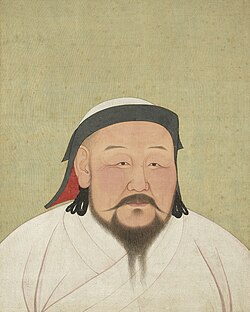কুবলাই খান: সংশোধিত সংস্করণের মধ্যে পার্থক্য
বিষয়বস্তু বিয়োগ হয়েছে বিষয়বস্তু যোগ হয়েছে
AvocatoBot (আলোচনা | অবদান) অ r2.7.1) (বট যোগ করছে: eu:Kublai Khan |
Movses-bot (আলোচনা | অবদান) অ r2.7.2) (বট পরিবর্তন করছে: az:Kubilay xan |
||
| ৫১ নং লাইন: | ৫১ নং লাইন: | ||
[[arz:قوبيلاى خان]] |
[[arz:قوبيلاى خان]] |
||
[[ast:Cublai Kan]] |
[[ast:Cublai Kan]] |
||
[[az: |
[[az:Kubilay xan]] |
||
[[bg:Кубилай хан]] |
[[bg:Кубилай хан]] |
||
[[ca:Khublai Khan]] |
[[ca:Khublai Khan]] |
||
০৫:৫৩, ১৫ মার্চ ২০১২ তারিখে সংশোধিত সংস্করণ

| |
| Khubilai Khan | |
|---|---|
| Birth and death: | Sept. 23, 1215–Feb. 18, 1294 |
| Clan name (obogh): | Borjigin[১] (Боржигин) Bei'erzhijin[২] (孛兒只斤) or Bo'erjijite[৩] (博爾濟吉特) |
| Sublineage name:[৪] |
Khiyad[৫] (Хиад) Qiwowen[৬] (奇渥溫) or Qiyan (乞顏) |
| Given name: | Khubilai (Хубилай) Hubilie (忽必烈) |
| Khan of the Mongols | |
| Dates of reign: | May 5, 1260–Dec. 17, 1271 |
| Emperor of Yuan China | |
| Dates of reign: | Dec. 18, 1271[৭]–Feb. 18, 1294 |
| Era Names: | Zhongtong, Zhiyuan |
| Dynasty: | Ön, now Yüanh (Юань) Yuan (元) |
| Khan name: | Setsen Khan (Сэцэн хаан) Xuechan Han (薛禪汗) |
| Temple name: | (Mongolian name to be added) Shizu (世祖) |
| Posthumous name: |
Never used short |
| Posthumous name: |
(Mongolian name to be added) Emperor Shengde Shengong Wenwu (聖德神功文武皇帝) |
| General note: Names given in Mongolian, then in Chinese. See Notes | |
কুবলাই খান (September 23, 1215[৮] - February 18, 1294[৯]) (Mongolian: Хубилай хаан খ়ুবিলায়্ খাং, চীনা: 忽必烈汗; ফিনিন: Hūbìliè Hàn খ়ুপিলিয়ে খ়্যান্ বা হুপিলিয়ে হান), মধ্যযুগের একজন মঙ্গল দলপতি এবং শাসনকর্তা। তিনি চীনের ইউয়ান রাজবংশের প্রতিষ্ঠাতা ও প্রথম সম্রাট হিসাবে ১২৭১ খ্রিস্টাব্দ হতে ১২৯৪ খ্রিস্টাব্দ পর্যন্ত চীন শাসন করেন।
কুবলাই খান ছিলেন তলুই ও সরঘাঘতানি বেকির দ্বিতীয় পুত্র। তাঁর পিতামহ ছিলেন চেঙ্গিস খান। ১২৬০ খ্রিস্টাব্দে কুবলাই খান তাঁর বড় ভাই মংকু খানের স্থলাভিষিক্ত হন। কুবলাই খানের আরেক ভাই হালাকু খান পারস্য জয় করেন এবং সেখানে ইলখানাত নামে রাজ্য প্রতিষ্ঠা করেন।
তথ্যসূত্র
- ↑ This is the singular. The plural is Borjigi.
- ↑ This is the most frequent Chinese version of the clan name nowadays.
- ↑ This Chinese version of the clan name was the most frequent during the Qing Dynasty.
- ↑ The Cambridge History of China thinks that Khiyad was a sublineage inside the larger Borjigin clan, but other scholars disagree and think that Borjigin was a sublineage inside the larger Khiyad clan, while there are those who think that Khiyad and Borjigin were both used interchangeably.
- ↑ This is the plural. The singular is Khiyan.
- ↑ This Chinese version of Khiyad is the one that appears in the Chinese history of the Yuan Dynasty.
- ↑ Founded the Yuan Dynasty on that day. However, was not in control of southern China until February 1276, when the Southern Song emperor was captured and the imperial seal was relinquished to the Yuan. The last pockets of resistance in southern China fell in 1279.
- ↑ Rossabi, Morris (১৯৮৮)। Khubilai Khan: His Life and Times। University of California Press। পৃষ্ঠা 13। আইএসবিএন 0-520-06740-1।
- ↑ Rossabi, Morris (১৯৮৮)। Khubilai Khan: His Life and Times। University of California Press। পৃষ্ঠা 227–228। আইএসবিএন 0-520-06740-1।
